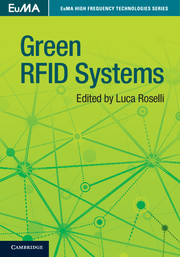Book contents
- Frontmatter
- Contents
- List of contributors
- Introduction
- 1 Context analysis
- 2 RFID background
- 3 Energy scavenging and storage for RFID systems
- 4 Technologies for RFID sensors and sensor tags
- 5 Unconventional RFID systems
- 6 Integrating tiny RFID- and NFC-based sensors with the Internet
- 7 Materials for substrates
- 8 Organic conductors and semiconductors: recent achievements and modeling
- 9 RFID enabling new solutions
- 10 Energy-efficient off-body communication using textile antennas
- Index
- References
8 - Organic conductors and semiconductors: recent achievements and modeling
Published online by Cambridge University Press: 05 October 2014
- Frontmatter
- Contents
- List of contributors
- Introduction
- 1 Context analysis
- 2 RFID background
- 3 Energy scavenging and storage for RFID systems
- 4 Technologies for RFID sensors and sensor tags
- 5 Unconventional RFID systems
- 6 Integrating tiny RFID- and NFC-based sensors with the Internet
- 7 Materials for substrates
- 8 Organic conductors and semiconductors: recent achievements and modeling
- 9 RFID enabling new solutions
- 10 Energy-efficient off-body communication using textile antennas
- Index
- References
Summary
Introduction
The idea of using organic materials, namely small molecules and conductive polymers, to realize electronic devices dates back to the beginnings of semiconductor technology. Yet, while silicon has become pervasive at a societal level, allowing the gigantic steps we have witnessed in the last decades, organic electronics has remained a niche field with relatively small impact. In recent years two novelties have generated a lot of interest in organic electronics and revitalized the field. On the one hand, organic light emitting diodes (OLED) displays have been brought to the market and are on their way to a dominant position with respect to liquid crystal. On the other, the discovery of graphene has been demonstrated and has fuelled incredible and unprecedented expectations. Some are already defining the twenty-first century as the “carbon” century, just as the previous century has been the “silicon” century.
This chapter aims to present the properties of conductive polymers and of graphene in the context of RFID development. Thus, we will deal with active components (e.g. diodes and transistors) based on pentacene, the best-known organic semiconductor, and passive components (e.g. antennas) based on graphene. The analyses are based on modeling and simulations, referring to the activities and results obtained by the groups at the Technische Universität München and at the Università Politecnica delle Marche, respectively. Such an approach allows us to discuss some of the physical properties of the underlying materials, to focus on their potential applications and, at the same time, to illustrate the simulation tools that are available for design and optimization. We will refer to the vast available literature for more details on material properties, fabrication techniques, and other applications.
- Type
- Chapter
- Information
- Green RFID Systems , pp. 195 - 227Publisher: Cambridge University PressPrint publication year: 2014



